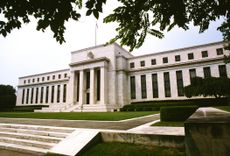US inflation is rising – but it’s not enough to rattle markets yet
The latest US inflation figures showed that consumer prices are rising more rapidly than expected. But markets shrugged. John Stepek asks why, and what it means for your portfolio.


US consumer price index inflation figures came out yesterday. Investors have been betting that reflation is on its way, and they are now looking for confirmation of that bet. So everyone was waiting for this latest reading with bated breath – and, as so often happens with the most-anticipated bits of data, it was all a bit of a damp squib. Consumer prices in the US rose at an annual rate of 2.6% in March. That was up from 1.7% in February, and a bit higher than the expected reading of 2.5%.
Now, obviously, this time last year inflation was diving because we were going into lockdown. So this reading suffers from “base effects”. In other words, we have an unusually low comparator month which means that this month was always going to look unusually high. However, as Will Denyer of Gavekal points out, even if you adjust for base effects, there is no doubt that “US inflation is trending up”.
There are two real questions at this point. One: how much inflation has the market already priced in? And two: how much more are we going to get? On the first point, the market was, to put it bluntly, underwhelmed by the figure. There were no fireworks. Bond yields didn’t push higher, and assets which have been struggling with higher interest rates (ie, rising bond yields) – including gold and the Nasdaq – did a bit better after the figure came out.
Subscribe to MoneyWeek
Subscribe to MoneyWeek today and get your first six magazine issues absolutely FREE

Sign up to Money Morning
Don't miss the latest investment and personal finances news, market analysis, plus money-saving tips with our free twice-daily newsletter
Don't miss the latest investment and personal finances news, market analysis, plus money-saving tips with our free twice-daily newsletter
In other words, the market reacted as though inflation had become less of an imminent threat than it had thought. The fact that the figure beat analysts’ expectations, yet didn’t inspire any big reaction in markets, makes it clear that investors were already heavily betting on a “surprise”. I realise that sounds a little bit contradictory. If markets are meant to price in the future, then why are they pricing in something different from the analysts’ consensus forecasts for the future?
The main thing to understand is that markets and analysts are two different things. There may be an analyst or economist consensus around an event, but if lots of investors already think that the data (or company report) will beat that consensus, then you won’t get much of a market reaction if it does. In other words, there’s a market consensus and an analyst consensus, and the two aren’t always the same. So markets were already positioned for a strong reading. The one they got was strong-ish, but not spectacularly so. Arguably, it was a bit of a damp squib as far as markets were concerned.
Meanwhile, we also got the news that the US medical regulator was putting a hold on the Johnson & Johnson vaccine for the moment. In practice, that doesn’t necessarily matter that much – the vast majority of vaccines in the US (where the rollout is going well) are Moderna or Pfizer. But clearly any stumbles on the road imply that it might take a bit longer to get to full activity again, which in turn is a negative for the reflation trade.
Add it all up and you have a day where the market was all revved up to tackle a mammoth inflation surprise, but instead got a pretty mild surprise, alongside some mildly disappointing news on the recovery side.
In the longer run, higher inflation is still the desired political solution
This is arguably the best possible outcome for the US Federal Reserve for now. It all points to a healthy recovery (so no major disappointment) but it also means investors will stop driving bond yields higher for the moment, which means the Fed can keep talking rather than acting. “Goldilocks” remains the core storyline. It also confirms that the “Great Rotation” trade is likely to continue taking a breather. We’ve already seen the Nasdaq hit fresh highs and we’re also seeing the Big Tech stocks finally get above the highs they last saw in August and September last year.
That doesn’t mean you should be trying to reposition yourself frantically – you’re not a day trader (probably) – you just shouldn’t be surprised if a different set of stocks sets the pace for now. In the longer run, my money is still on inflation coming back stronger and faster than most investors still expect.
As Peter Spiller of Capital Gearing Trust, which has an excellent long-term track record, pointed out in a recent piece for Citywire, “Inflation is not just necessary; we think it is probable”. The reality is that it’s the least painful way – politically speaking – to get rid of the debt. So they’ll keep trying until it happens, one way or the other.
By the way, Merryn will be interviewing Peter for the MoneyWeek podcast shortly. Look out for that one – and if you haven’t listened before, you can peruse our previous podcasts here.
John is the executive editor of MoneyWeek and writes our daily investment email, Money Morning. John graduated from Strathclyde University with a degree in psychology in 1996 and has always been fascinated by the gap between the way the market works in theory and the way it works in practice, and by how our deep-rooted instincts work against our best interests as investors.
He started out in journalism by writing articles about the specific business challenges facing family firms. In 2003, he took a job on the finance desk of Teletext, where he spent two years covering the markets and breaking financial news. John joined MoneyWeek in 2005.
His work has been published in Families in Business, Shares magazine, Spear's Magazine, The Sunday Times, and The Spectator among others. He has also appeared as an expert commentator on BBC Radio 4's Today programme, BBC Radio Scotland, Newsnight, Daily Politics and Bloomberg. His first book, on contrarian investing, The Sceptical Investor, was released in March 2019. You can follow John on Twitter at @john_stepek.
-
 Should you invest in UK equities?
Should you invest in UK equities?The FTSE 100 hit a record high this week, but UK equities remain unloved and undervalued compared to their global and US peers. Should you snap them up at a discount?
By Katie Williams Published
-
 State pension errors: DWP urged to check for mistakes among divorced people
State pension errors: DWP urged to check for mistakes among divorced peopleFormer pensions minister Steve Webb says there are a high number of divorced women on low state pensions. Now MPs want the DWP to check if there were any errors in “potentially underpaying men and women who are divorced”.
By Ruth Emery Published
-
 UK wages grow at a record pace
UK wages grow at a record paceThe latest UK wages data will add pressure on the BoE to push interest rates even higher.
By Nicole García Mérida Published
-
 Trapped in a time of zombie government
Trapped in a time of zombie governmentIt’s not just companies that are eking out an existence, says Max King. The state is in the twilight zone too.
By Max King Published
-
 America is in deep denial over debt
America is in deep denial over debtThe downgrade in America’s credit rating was much criticised by the US government, says Alex Rankine. But was it a long time coming?
By Alex Rankine Published
-
 UK economy avoids stagnation with surprise growth
UK economy avoids stagnation with surprise growthGross domestic product increased by 0.2% in the second quarter and by 0.5% in June
By Pedro Gonçalves Published
-
 Bank of England raises interest rates to 5.25%
Bank of England raises interest rates to 5.25%The Bank has hiked rates from 5% to 5.25%, marking the 14th increase in a row. We explain what it means for savers and homeowners - and whether more rate rises are on the horizon
By Ruth Emery Published
-
 UK wage growth hits a record high
UK wage growth hits a record highStubborn inflation fuels wage growth, hitting a 20-year record high. But unemployment jumps
By Vaishali Varu Published
-
 UK inflation remains at 8.7% ‒ what it means for your money
UK inflation remains at 8.7% ‒ what it means for your moneyInflation was unmoved at 8.7% in the 12 months to May. What does this ‘sticky’ rate of inflation mean for your money?
By John Fitzsimons Published
-
 VICE bankruptcy: how did it happen?
VICE bankruptcy: how did it happen?Was the VICE bankruptcy inevitable? We look into how the once multibillion-dollar came crashing down.
By Jane Lewis Published